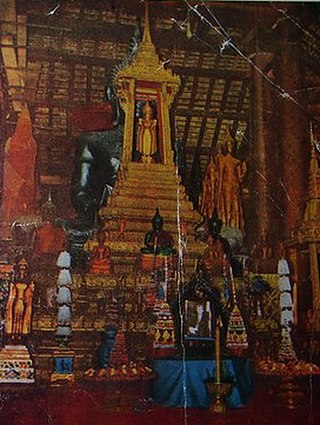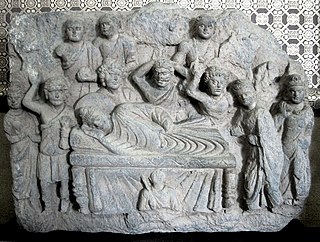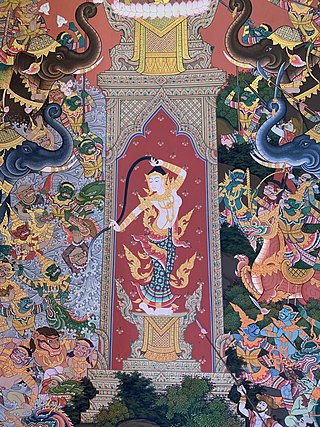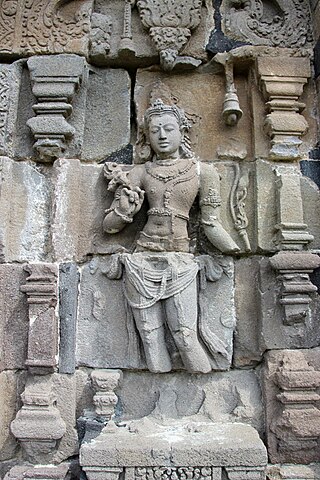
Wat Phra Kaew, commonly known in English as the Temple of the Emerald Buddha and officially as Wat Phra Si Rattana Satsadaram, is regarded as the most sacred Buddhist temple in Thailand. The complex consists of a number of buildings within the precincts of the Grand Palace in the historical centre of Bangkok. It houses the statue of the Emerald Buddha, which is venerated as the country's palladium.

The Phra Bang is a statue of Buddha in the city of Luang Prabang, Laos; it is the namesake of that city. The statue stands at 83-centimetre (33 in)s, with palms facing forward, cast using thong, an alloy of bronze, gold, and silver. According to local lore, it was cast in Ceylon sometime between the 1st and 9th century. However, the features of the image suggest a much later Khmer origin.

A mudra is a symbolic or ritual gesture or pose in Hinduism, Jainism and Buddhism. While some mudras involve the entire body, most are performed with the hands and fingers.

Much Buddhist art uses depictions of the historical Buddha, Gautama Buddha, which are known as Buddharūpa in Sanskrit and Pali. These may be statues or other images such as paintings. The main figure in an image may be someone else who has obtained Buddhahood, or a boddhisattva, especially in the various traditions of Mahayana Buddhism. Other Buddhas and bodhisattvas in art have become increasingly common over the centuries, perhaps now outnumbering images of the historical Buddha.

A reclining Buddha is an image that represents Buddha lying down and is a major iconographic theme in Buddhist art. It represents the historical Buddha during his last illness, about to enter the parinirvana. He is lying on his right side, his head resting on a cushion or relying on his right elbow, supporting his head with his hand.

Dakshinamurti is an aspect of the Hindu god Shiva as a guru (teacher). He is regarded to be the personification of the supreme or the ultimate awareness, understanding, and knowledge. Dakshinamurti represents Shiva as a teacher of yoga, music, and wisdom, offering an exposition of the Shastras. He is worshipped as the god of wisdom and meditation.

The abhayamudra is a mudra (gesture) that is the gesture of reassurance and safety, which dispels fear and accords divine protection and bliss in Hinduism, Buddhism, and other Indian religions. The right hand is held upright, and the palm is facing outwards. This is one of the earliest mudras found depicted on a number of Hindu, Buddhist, Jain, and Sikh images.

Vasudhārā whose name means "stream of gems" in Sanskrit is as known call as "Gold Tara", is the Buddhist goddess of Wealth, prosperity, and abundance. Her popularity peaks in Nepal where she has a strong following among the Buddhist Newars of the Kathmandu Valley and is thus a central figure in Newar Buddhism. She is one of the most popular goddesses worshipped in many Buddhist countries and is a subject of Buddhist legends and art.
Korean Buddhist sculpture is one of the major areas of Korean art. Buddhism, a religion originating in what is now India, was transmitted to Korea via China in the late 4th century. Buddhism introduced major changes in Korean society. The complexity of the religious sutras sent to Korea required the aristocrats who adopted the religion to become literate and required the training and importation of literate scribes. Little evidence of religious art exists in Korea before the introduction of Buddhism. Subsequent to its introduction, the religion inspired the production of devotional art as well as the beginnings of sophisticated temple architecture.

A Buddha image in Thailand typically refers to three-dimensional stone, wood, clay, or metal cast images of the Buddha. While there are such figures in all regions where Buddhism is commonly practiced, the appearance, composition and position of the images vary greatly from country to country in Buddhist art.

The Buddha Tooth Relic Temple and Museum is a Buddhist temple and museum complex located in the Chinatown district of Singapore. The temple's monastics and devotees officially practice Chinese Buddhism.

Wat Ong Teu Mahawihan is one of many Buddhist monasteries in the city of Vientiane in Laos. This name is given to the temple due to the large, bronze Phra Ong Teu Buddha image that is in the temple: the largest Buddha in Vientiane. This temple was initially constructed by King Setthathirath I in the 16th century when Laos was being bombarded by the Burmese, but was later demolished during a foreign invasion. Thus, it may have gone through many reconstructions during the 19th or 20th century to attain the appearance it has today.

Vasundharā or Dharaṇī is a chthonic goddess from Buddhist mythology of Theravada in Southeast Asia. Similar earth deities include Pṛthivī, Kṣiti, and Dharaṇī, Vasudhara bodhisattva in Vajrayana and Bhoomi devi and Prithvi in hinduism.

The many different varieties of Buddhist art often show buddhas and bodhisattvas, as well as depictions of the historical Buddha, known as Gautama Buddha.
Buddhavanam is a tourism project in Nagarjuna Sagar, Telangana created by the Telangana Tourism Development Corporation. The project was sanctioned by the Government of India viz., Integrated Development of Nagarjunasagar as part of Lower Krishna valley Buddhist circuit with a view to attract large number of domestic and foreign tourists particularly from the South-East Asian countries.

Leela attitude is an attitude of Buddha in Southeast art of which the Buddha is stepping with his right foot and his right-hand swinging and the other hand put towards to the front. The attitude is sometimes called the Walking Buddha.

Māravijaya attitude is an attitude of Buddha in Thai art of which the seated Buddha is putting his hand in the relax posture towards to the ground, loosely holding his knee. The other hand is on his lap. His eyes, sometimes closed, look down to the ground. The gesture of the hand reaching the ground is called bhumisparshamudra, which also refers to the attitude as well. The gesture refers to the episode which the Buddha calling the earth to witness.

The meditation attitude, also known as meditating Buddha, is an attitude of Buddha in which the seated Buddha rests both upturned hands on his lap, the right hand usually on top. His eyes are closed. The attitude refers to an episode where he reached enlightenment, meditating in this posture under the Bodhi tree.

Naga Prokattitude (Thai: ปางนาคปรก; RTGS: pang nak prok), translated as "sheltered-by-the-naga Buddha", is an attitude of Buddha in Burmese, Khmer, Lao and Thai art in which the Buddha, seated in either the meditation or maravijaya attitude, is sheltered by or covered with a multi-headed nāga. The nāga, whose name is Mucalinda, usually has seven or nine heads and appeared to coil the base of the Buddha statue.

The Eight Great Events (aṣṭamahāpratihārya) are a set of episodes in the life of Gautama Buddha that by the time of the Pala Empire of North India around the 9th century had become established as the standard group of narrative scenes to encapsulate the Buddha's life and teachings. As such they were frequently represented in Buddhist art, either individually or as a group, and recounted and interpreted in Buddhist discourses.

























